
Lower Saxony is a German state in northwestern Germany. It is the second-largest state by land area, with 47,614 km2 (18,384 sq mi), and fourth-largest in population among the 16 Länder federated as the Federal Republic of Germany. In rural areas, Northern Low Saxon and Saterland Frisian are still spoken, albeit in declining numbers.

Westphalia is a region of northwestern Germany and one of the three historic parts of the state of North Rhine-Westphalia. It has an area of 20,210 square kilometres (7,800 sq mi) and 7.9 million inhabitants.

The Teutoburg Forest is a range of low, forested hills in the German states of Lower Saxony and North Rhine-Westphalia. Until the 17th century, the official name of the hill ridge was Osning. It was first renamed the Teutoburg Forest in 1616 in commemoration of the Battle of the Teutoburg Forest in 9 AD, which most likely took place at Kalkriese instead.
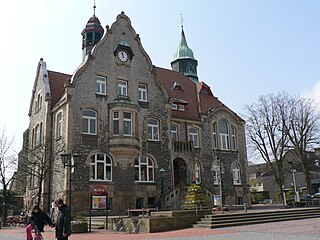
Melle is a city in the district of Osnabrück, Lower Saxony, Germany. The city corresponds to what used to be the district of Melle until regional territorial reform in 1972. Since then Melle is the third largest city in Lower Saxony in terms of surface area.
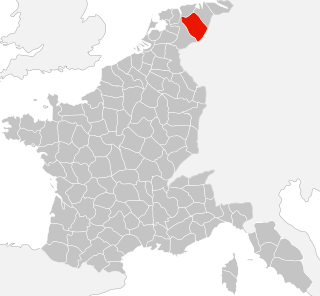
Ems-Supérieur was a department of the First French Empire in present-day Germany. It was formed in 1811, when the region was annexed by France. Its territory was part of the present-day German lands Lower Saxony and North Rhine-Westphalia. Its capital was Osnabrück.

The Province of Hanover was a province of the Kingdom of Prussia and the Free State of Prussia from 1868 to 1946.

The Prince-Bishopric of Münster was a large ecclesiastical principality in the Holy Roman Empire, located in the northern part of today's North Rhine-Westphalia and western Lower Saxony. From the sixteenth to the eighteenth centuries, it was often held in personal union with one or more of the nearby ecclesiastical principalities of Cologne, Paderborn, Osnabrück, Hildesheim, and Liège.
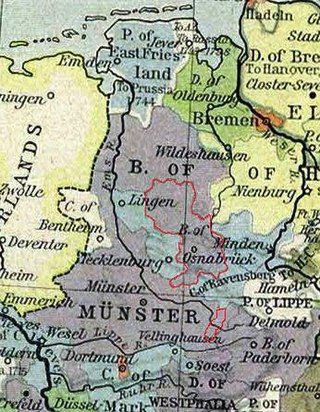
The Prince-Bishopric of Osnabrück) was an ecclesiastical principality of the Holy Roman Empire from 1225 until 1803. It should not be confused with the Diocese of Osnabrück, which was larger and over which the prince-bishop exercised only the spiritual authority of an ordinary bishop. It was named after its capital, Osnabrück.

Münster Hauptbahnhof is the main railway station in the city of Münster in Germany.

Osnabrück Hauptbahnhof is a railway station located in Osnabrück, Germany. The station was opened in 1895 and is located on the Wanne-Eickel–Hamburg, Löhne–Rheine, Osnabrück–Bielefeld and the Oldenburg–Osnabrück lines. The train services are operated by Deutsche Bahn, Hamburg-Köln-Express, NordWestBahn, Eurobahn and WestfalenBahn. The station features two levels, with lines at right angles to each other.

Osnabrück Altstadt is a railway station located in Osnabrück, Germany. The station is located on the Löhne–Rheine and the Oldenburg–Osnabrück lines. The train services are operated by Eurobahn, NordWestBahn, and WestfalenBahn.

Oldendorf is a former municipality, now part of Melle, in the district of Osnabrück, in Lower Saxony, Germany. It is on the southern slope of the Wiehengebirge, between the cities of Osnabrück and Bielefeld.
The Hanoverian Western Railway was a line from the Löhne to Emden, built by the Royal Hanoverian State Railways in the mid-19th century in the west of the Kingdom of Hanover in the modern German states of Lower Saxony and North Rhine-Westphalia.

The Löhne–Rheine railway is a two-track, continuously electrified railway main line from Löhne in the German state of North Rhine-Westphalia via Osnabrück in Lower Saxony to Rheine in North Rhine-Westphalia. It runs parallel to the Wiehen Hills to the north and to the Teutoburg Forest to the south. The line opened in 1855 and 1856 and was one of the oldest railways in Germany.

The Route of Megalithic Culture was first created as a tourist route that meanders from Osnabrück to Oldenburg in North-West Germany. Signposted with brown road signs it links many places of archaeological interest from the Megalithic era.
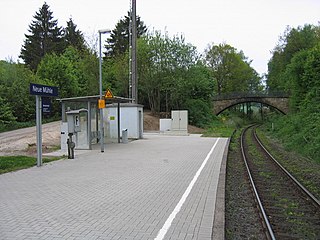
The Bassum–Herford Railway is a now partially disused railway line from Herford in the German state of North Rhine-Westphalia via Bünde to Bassum in Lower Saxony.
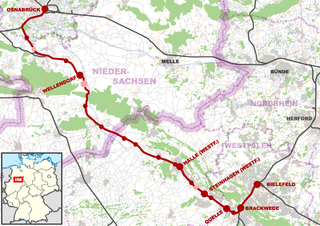
The Osnabrück–Brackwede railway, also the called the Haller Willem, is a single-track branch line running through the Teutoburg Forest from Osnabrück via Dissen-Bad Rothenfelde and Halle (Westf) to Brackwede in the German state of North Rhine-Westphalia. The line is known for its steep climb to the Teutoburg Forest, where a tunnel was omitted for cost reasons. The railway was built in 1886 in response to demands for a line from Osnabrück to Bielefeld. In 1984, the section from Osnabrück to Dissen-Bad Rothenfelde was closed for passenger traffic, freight traffic continued until 1991. After numerous protests this section of track was reactivated in 2005. The entire line is owned by Deutsche Bahn, but the section from Dissen-Bad Rothenfelde to Osnabrück has been leased to the Verkehrsgesellschaft Landkreis Osnabrück. The Brackwede–Dissen section is part of Deutsche Bahn’s Münster-Ostwestfalen regional network (MOW).
The Ems-Leine-Express is the name of a German Regional-Express service in North Rhine-Westphalia that has connected the Emsland city of Rheine, Lower Saxony, the regional centre of Osnabrück, the east Westphalian city of Minden and the Lower Saxony regional centres of Hanover and Braunschweig since 5 November 2000.

WestfalenBahn is a railway company operating regional train service in Lower Saxony and North Rhine-Westphalia, Northern Germany. It was founded in 2005 by Essener Versorgungs & Verkehrsgesellschaft, Minden Museum Railway, moBiel and Verkehrsbetriebe Extertal, each having a 25% share. In 2008 Essener Versorgungs & Verkehrsgesellschaft's share was sold to Abellio Deutschland. In July 2017 Abellio bought out the other shareholders.

Matthias Seestern-Pauly is a German teacher and politician of the Free Democratic Party (FDP) who has been serving as a member of the Bundestag from the state of Lower Saxony since 2017.

![]() listen )) is a district (Landkreis) in the southwest of Lower Saxony, Germany. With 2,122 km² it is the second largest district of Lower Saxony.
listen )) is a district (Landkreis) in the southwest of Lower Saxony, Germany. With 2,122 km² it is the second largest district of Lower Saxony.



















